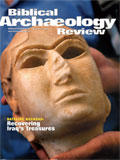
Got my latest Biblical Archaeology Review in the mail this week.
Fascinating article about the plundering immediately after Saddam's fall. Over 13,000 artifacts were stolen in just 11 days - many major finds and historically important objects. "World's oldest known" kind of stuff - just taken by looters.
The article is written by the US military colonel commissioned with restoring and recovering the museum. They had to inventory the smashed, messed up place, send pictures of important missing stuff to border patrols and law enforcement agencies internationally, conduct raids on places/people they knew had stolen stuff, and simultaneously gain the trust of the Baghdad citizens, so they would return stuff without fear of punishment.
On the last, they visited cafes without helmets, publicizing that anyone returning anything would not be charged or asked any questions. It would just be taken back. No rewards would be given for artifacts, either, except for information leading to stolen objects.
It was hard to convince the citizens of the no-punishment part, given Saddam's brutality. Once in 1999 when burglars stole a piece and were caught, they were all beheaded under Hussein's regime.
But it has worked, partially. Over 5,000 articles have been returned, including many of the most important, all without financial reimbursement. Stuff from 6,000 BC coming back in garbage bags. While the colonel was on leave in New York (!), he got a call, and met a middle man in a mid-town Manhattan cafe, recovering a 4,000 year old piece. Portable stove/furnaces used by kings in 700 BC, as well as some of their "crown jewels" - restored. The picture above is the oldest known rendering of a human face ever found (3100BC). It was recovered in a pre-dawn raid on a farm just north of Baghdad, buried a foot and a half underground.
Why loot? To resell and gain financially. Out of spite against Saddam. Ironically, to altruistically save stuff from destruction and looting.
Why inform against another? Again, to save stuff. To do justice. Mercenarily, to get a financial reward, which they did. To put rival dealers out of business (!).
On the military end, this was also an enlightening story.
When the USA invaded Baghdad, the army used the Museum as a military position, with snipers firing rocket-propelled grenades from the upper stories. The children's museum was in the same building, and also had snipers in it. Uproar came when the US tanks fired and hit the children's museum, but they only missed the snipers who had fired at them first by 1-2 feet.
After the occupation had been in place for a while, one day an older couple came in claiming the Islamic manuscript museum they were curators in was being burgled. The task force swung into action, SWAT-teaming the place, in a very vulnerable, exposed position, militarily. Nobody was there! Turns out the place had been burgled the day before, were planning on coming back for more, and this was a test, to see if the good-ole US of A would actually risk themselves for an Islamic site.
The kicker is this. Smuggling. The two biggest ticket items to smuggle in Iraq right now are weapons and antiquities. And they're smuggled together. You might have been wondering how the US military got involved in restoring an archaeology museum. Because if you follow the antiquities, you'll find weapons, and when you find smuggled weapons, you've found insurgents. People buying smuggled-out antiquities are partially and indirectly funding and supporting Iraqi insurgents against the US. This is hard to stop because it is such a profitable business. Even other nations are difficult to convince, sometimes, because they can make such a killing taking under the table bribes to let stolen merchandise over a border.
No comments:
Post a Comment